Six days before, Danny Davis had never even worn a pair of crampons; now he was hoofing it alongside Jeremy Jones and Nick Russell in an extended backcountry mission in the Sierra Nevada. This was only part of their crew. Waiting below was backcountry guru Nick Schnieder, and snowboarding legend Kevin Pearce even tagged along for a few days. Meanwhile, documenting the whole adventure was a small film crew, that would later compile their adventures into the short film High Country Caravan.
There was about an hour’s worth of stair-stepping in crampons to get to the top of this line. Davis wasted no time ripping the torture devices from his feet. Once freed, he turned his attention from the pain in his toes to the spoils of their hard work. In front of them, an endless mountain range unfolded. Even though they were able to push 30 miles past the High Sierra’s Front Range, this trip didn’t even scratch the surface of what was really tucked away back here. It was only the beginning.
RELATED: Human Powered — Why Cody Townsend Ditched the Heli for Touring Skis.
Satiated from the view, it was time to enjoy the real reward. Waiting below them was an open face just waiting to be carved. Drunk with joy, they railed down the slope. Reaching the bottom was bittersweet since they’d have to pack up camp and head back out on this perfect spring day. Six days weren’t enough. But spirits soared high as they trotted down from the mountains. It wouldn’t be long until they were back.
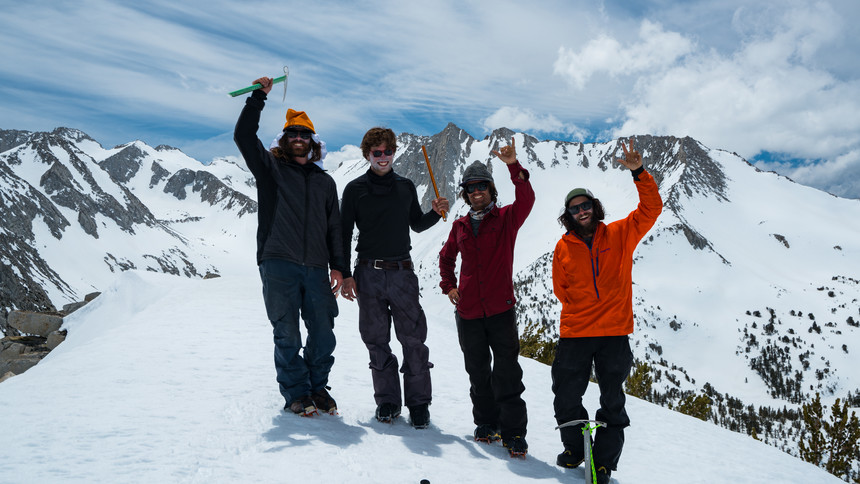 Danny Davis, Jeremy Jones, Kevin Pearce, and Nick Russell celebrate reaching the summit. Ming Poon Photo.
Danny Davis, Jeremy Jones, Kevin Pearce, and Nick Russell celebrate reaching the summit. Ming Poon Photo.
A Backyard Adventure
It is equally concerning and comforting when a snowboarder as accomplished as Jeremy Jones admits that he’s nervous. That’s how the High Country Caravan started. But to his credit, their goal was ambitious: a six-day self-supported mission in the Sierra Nevada backcountry.
Jones’ passport is decorated with stamps from all across the globe. While snowboarding has brought him as far as the Himalayas, doing a self-supported trip of this nature was taking his career into a new direction.
The Sierra Nevada is a special yet elusive range. It originates from the Mojave Desert and terminates about 400 miles north where it meets the Cascades. Around Lake Tahoe, the stretch of mountains is about 80 miles wide and stacked with countless unnamed peaks. Jones and Russell steadily became aware of this fact as they explored the Sierra’s Front Range during the 2016/17 season.
Each time the splitboarders bagged a new peak, they’d longingly gaze on what was just out of reach. The thing was, just to even tap into this tantalizing zone, a whole lot of walking was required. Simply getting to one of these peaks can take roughly a day, so a movable basecamp would be the most effective method. The two of them had already spent a decent time bushwacking in the backcountry, but executing a self-supported caravan was new territory. “Anytime you reach the summit ridge of a peak on the front lines, your mind is eternally blown at the endless terrain that hides behind it. Even thinking to dip into the deeper layers is a little overwhelming but extremely enticing,” said Russell.
Jones and Russell weren’t the only ones scoping the next bend in the High Sierra. That season was a special one for halfpipe rider Danny Davis, who had upped his big mountain riding game. Taking a page from role models like Nicolas Müller and Terje Haakonsen, Davis’ career began to transition into freeriding. “The halfpipe gets repetitive. If I was only climbing mountains and splitboarding I’m sure I’d get tired of that too. I just love to switch things up and expand my riding,” Davis explained. He might not have had the same breadth of technical knowledge as his comrades, but 17 years of contest riding lent him the ability to handle variable terrain. This trip might have been the first time he’s wielded an ice ax, but snowboarding ice? Easy. “Danny is one of the best snowboarders on the planet, so his ability to transfer that foundation of edge control from the pipe to line riding was a natural transition,” admitted Russell who’s closely followed Davis’ progression.
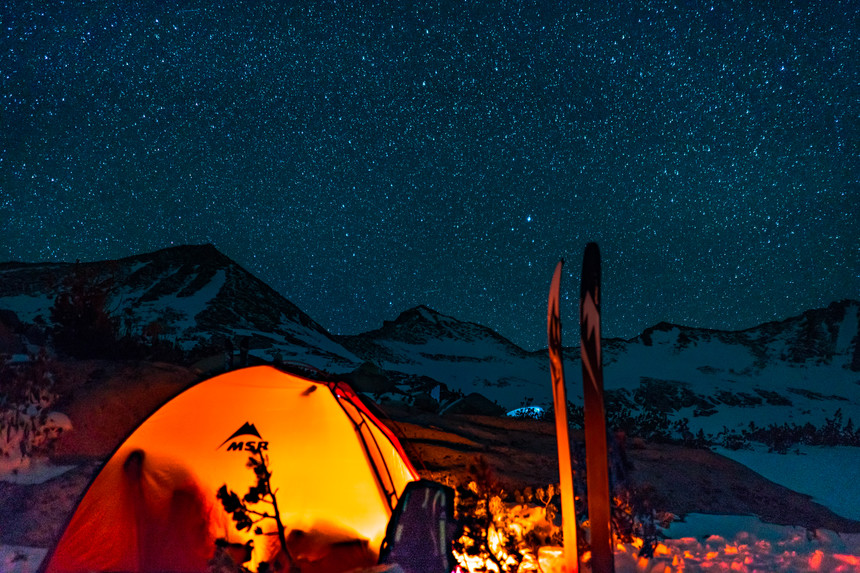 Not your average four-star hotel. Ming Poon Photo.
Not your average four-star hotel. Ming Poon Photo.
Still, things like crampons and winter camping were firsts for Davis, and who better to learn from than Jones and Russell, who were completely in their element.
Jones was fired up about this mission for a variety of reasons. On top of peeling back a new layer of his backyard mountain range, there was one item on his to-do list for years: get his friend Kevin Pearce into some real mountains. “For years we’ve all talked about getting Kevin out into the mountains with us. I always thought that the slower pace and low impact nature of splitboarding would be the perfect segway for him to get back out there,” explained Russell who’s known Pearce since he was a kid.
Coming into this trip, Pearce exuded nothing but enthusiasm. In 2009, at the height of his career, Pearce’s life was flipped upside down when he caught his toe edge while training for the 2010 Olympics. His head took the full force of the crash, leaving Pearce with a traumatic brain injury that would change his life forever. 49 days before the Olympics he went from setting the standard in snowboarding to relearning simple tasks. Not able to risk hitting his head again, Pearce was forced to retire from competitive riding. However, he didn’t have to leave snowboarding as a whole. It’s still very much a core tenant of his life, and is one of the ways he’s been able to move forward from his injury.
Plus, as he argues in High Country Caravan, what better medicine is there than Mother Nature?
Lastly, they were joined by the Sierra Phantom, a.ka. Nick Schneider. He’s a familiar face if you’ve seen TGR’s Ode to Muir. Schneider is notorious for quietly putting down descents on many of the unnamed peaks in the High Sierra. If you ever come across a mysterious lonesome snowboard track in this area—it’s probably the work of Schneidy. Prior to heading out into the wilderness, the veteran members—Jones, Russell, and Schneider—spent hours pouring over topographical maps of the area. Once they had charted a course and packed their belongings, the crew felt ready.
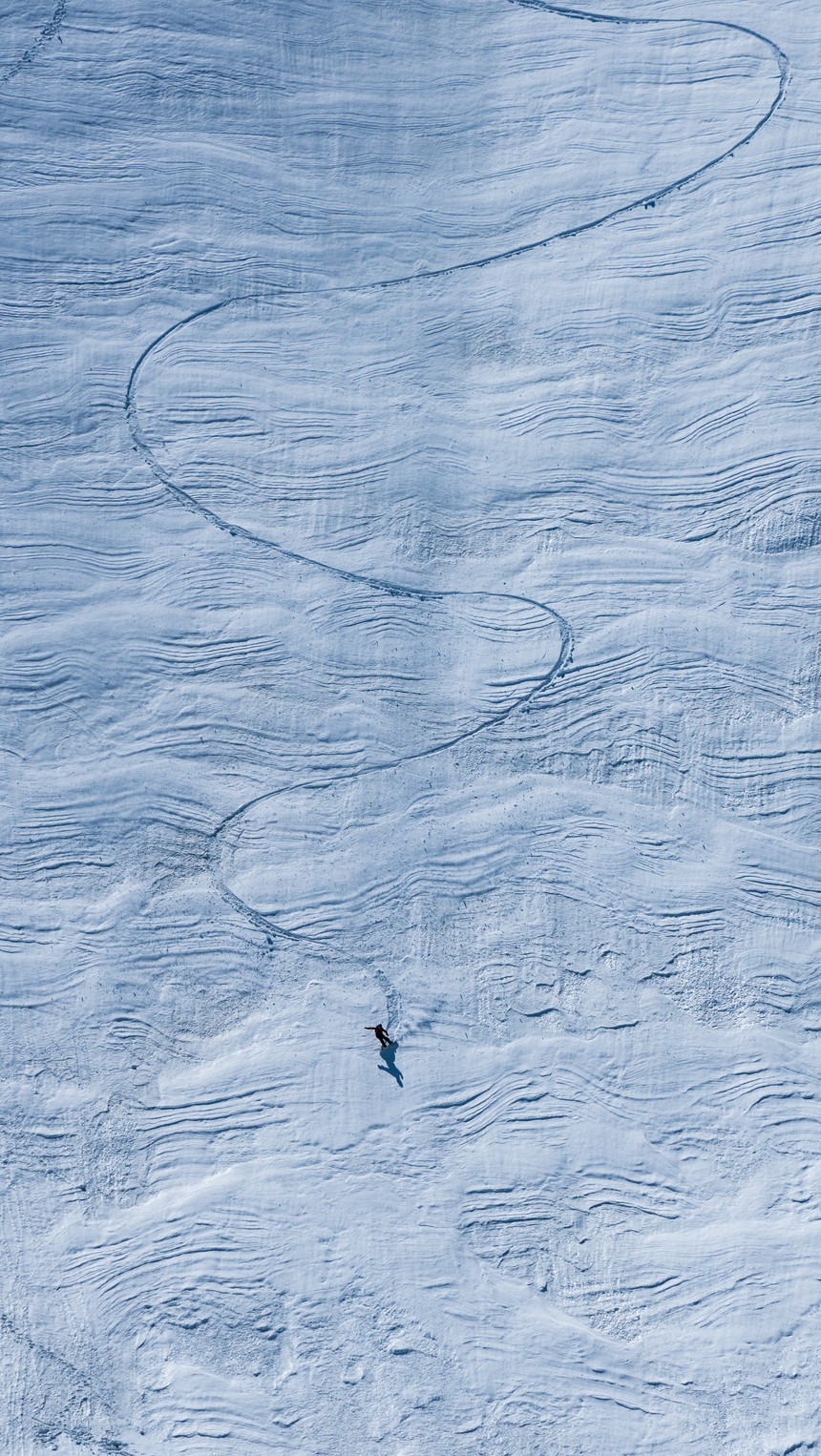 Jeremy Jones—always the artist—paints a sinuous line down the mountain. Ming Poon Photo.
Jeremy Jones—always the artist—paints a sinuous line down the mountain. Ming Poon Photo.
Learning along the way
Regardless of the range of their experiences, they all shared one common factor: enthusiasm. “Everyone was excited about the people they were out there with,” explained Davis.
There was no sponsor for the project. Instead, Davis reached out to filmer Scott Barber and Jones called up on-slope cameraman Ming Poon for additional cinematography and photography. By bringing along this spartan production crew, the team hoped to create a visual model to present to their sponsors. “We were just creating something at the moment for a project that people were excited about, and it was going to happen no matter what,” Barber explained. This passion project could be easily replicated, and that’s what they needed to demonstrate.
“I learned every day I was with them,” explained Barber, who had never tackled a trip of this scale before. Prior to joining their expedition, he had spent five weeks winter camping up at Everest basecamp, so he was no stranger to filming in extreme conditions. But doing a self-supported mission in conjunction with a short film was a unique challenge in itself. Beyond necessary winter gear, both he and Poon had to strategically pack enough camera equipment to pull it off. Trying to figure out the perfect amount of gear to bring was one of the toughest parts of the trip for Barber. “My camera rig set up was much lighter than what I’d normally work with,” he explained. “It made me have to grapple with issues that were out of my control.” The little things add up, like having to swap a sturdier tripod for a much lighter one. Not an issue at first glance, but if the wind picked up they’d be in trouble. And of course, it’s impossible to really ever know how many batteries and memory cards to bring—especially when dealing with the cold.
“We experienced a little bit of everything, but overall it worked out great,” Barber reflected but these minor hiccups were really insignificant in the grand scheme of things because when they finally trekked out of the backcountry, they had all succeeded in different ways.
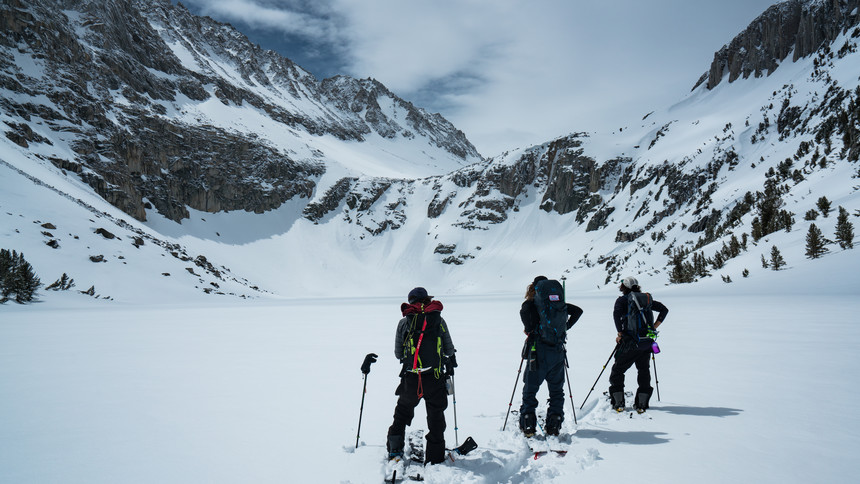 This trip had the crew viewing the Sierra in a whole new light. Ming Poon Photo.
This trip had the crew viewing the Sierra in a whole new light. Ming Poon Photo.
“To choose one standout moment is difficult. Just looking back on the whole trip, it was awe-inspiring to see the level of excitement those guys have for the mountains. Turning every corner and finding the next line only got them more excited,” Barber explained.
But if anything trumped this level of stoke it was watching his close friend Pearce—who was still finding his footing in big mountain snowboarding—crush hefty lines. Barber gets asked a lot about how Pearce has been coping with his brain injury. Now, his response recounts what he saw Pearce do in the High Sierra. “Seeing him snowboard lines like that and to be fully capable was a standout moment of the trip and my friendship with him,” Barber said. Russell also echoed Barber's sentiments. "Once a pro, always a pro. Even with Kev’s injury in 2009, he has maintained a high level of athleticism and has that focus of a champion ingrained in his blood. There were certainly concerns before heading out, but he was all smiles right next to us the entire time," Russell explained.
Setting the Stage
The primary goal of this trip wasn’t to produce a film, but to have the experience set the foundation for future projects to follow. “It was really special to see what they were able to do with the knowledge from High Country Caravan,” Barber said.
Unbeknownst to many, High Country Caravan is really the Batman Begins of an epic series of backcountry missions created for the silver screen. This trip had an immense influence on Russell’s film The Range of Mystery and Jones’ and TGR’s Ode to Muir (OTM) and current project in the works Roadless. It demonstrated to each of them what was possible, and lit a fire for further exploration that couldn’t be quelled.
“HCC was my first big backcountry trip. Following that, last year we went to Bolivia for Range of Mystery—which was HCC on steroids. Now, this spring we’re going to do Denali,” Davis said.
For Jones’, who had been wrestling with this idea for ages, it proved to be a perfect testing ground. He constantly kept tabs with the crew to collect beta to use later for OTM. By the time they wrapped the mission it confirmed his hunch that not only was this sustainable from a snowboarding perspective, but he could bring a film crew too. “Hearing about Ode and talking to Nick Kalisz, who handled the cinematography, about the gear he was able to bring for that film trip was super impressive and inspiring. Hopefully, people appreciate this project as being an early stage to what Ode to Muir ended up being,” Barber explained.
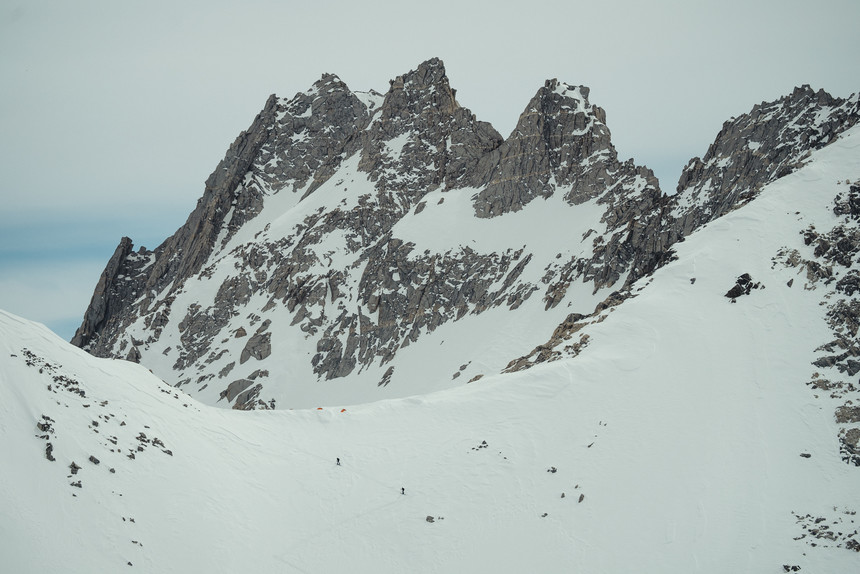 Jones took what he learned from HCC and put it to good use for TGR's Ode to Muir. Nick Kalisz Photo.
Jones took what he learned from HCC and put it to good use for TGR's Ode to Muir. Nick Kalisz Photo.
And if there’s one particular takeaway from the HCC, it’s about tapping into what’s waiting right before our eyes. “If you enjoy this type of snowboarding, there is truly no better place to be. If you’re willing to put in the work to get out there, paradise awaits. HCC definitely planted the seed for a lifetime worth of exploration,” said Russell.
Six days weren’t enough for the Sierra. Eight days wasn’t either. The hard truth is that it’d take a lifetime to unearth every nook and cranny hidden away in this mountain range. “Once you push one tier back there's an endless amount of terrain. It just makes you want to keep pushing further and further,” Davis said. The same goes for the Tetons, the Wasatch, and other zones throughout North America. Adventure isn’t all too far from our doorsteps. It just might require a little bit of walking.



play
May 18th, 2019
I love this website games. this is my favourite games website because more user are play the more user are play the more spades games games are this website.
Caden
October 5th, 2019
I like the way you explain things and the other one is the video portion. The live.me free coins share what you explain.
About The Author
stash member Katie Lozancich
TGR Staff Writer and photographer. Fond of bikes, pow, and dogs. Originally from Northern CA, home for me has ranged from the PNW to a teepee in Grand Teton National Park.
Connect with TGR:
Get TGR Email Updates: